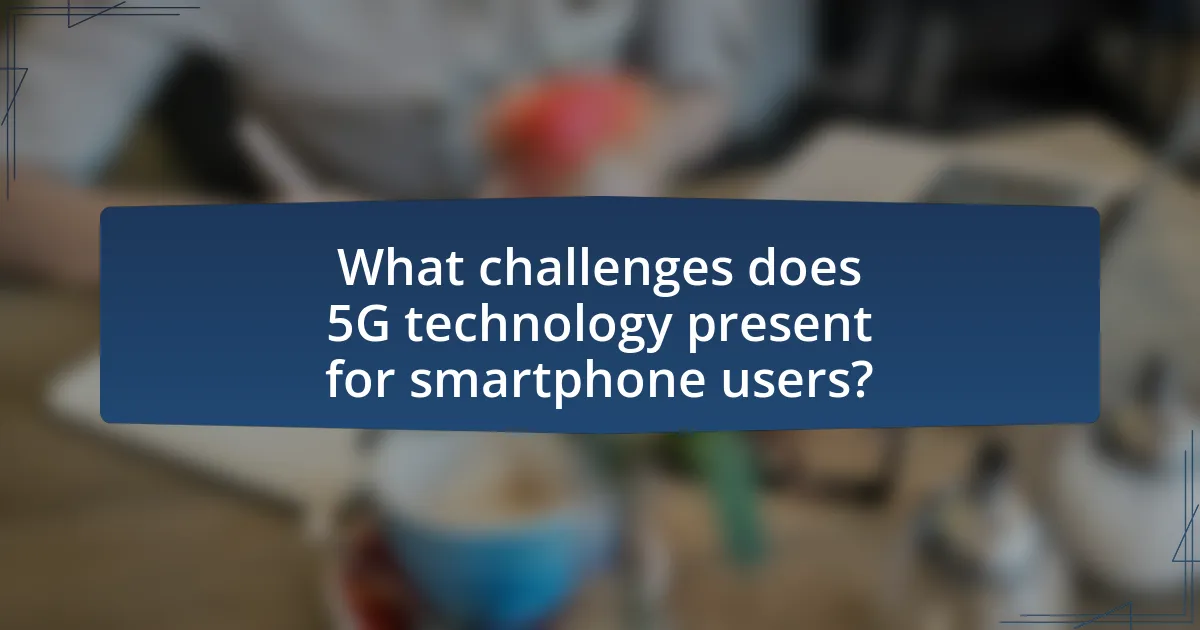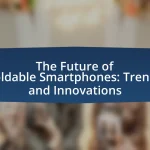The article examines the impact of 5G technology on smartphone performance, highlighting its significant enhancements in data speeds, latency, and connectivity. With capabilities reaching up to 10 Gbps and latency as low as 1 millisecond, 5G technology transforms user experiences in areas such as mobile gaming, streaming, and real-time applications. The discussion includes the differences between 5G and previous generations, necessary hardware upgrades for compatibility, and the implications for smartphone design and software optimization. Additionally, the article addresses challenges users may face, including battery consumption and coverage issues, while providing best practices for maximizing 5G performance on smartphones.

What is the Impact of 5G Technology on Smartphone Performance?
5G technology significantly enhances smartphone performance by providing faster data speeds, lower latency, and improved connectivity. With data rates reaching up to 10 Gbps, 5G allows for quicker downloads and smoother streaming experiences compared to 4G. Additionally, the reduced latency, often below 10 milliseconds, enables real-time applications such as gaming and augmented reality to function more effectively. Furthermore, 5G supports a higher number of connected devices, which improves overall network efficiency and user experience. These advancements are backed by studies indicating that 5G networks can handle up to 1 million devices per square kilometer, vastly outperforming previous generations.
How does 5G technology differ from previous generations?
5G technology differs from previous generations primarily through its significantly higher data transfer speeds, lower latency, and increased capacity for connected devices. While 4G networks typically offer speeds up to 1 Gbps, 5G can reach speeds exceeding 10 Gbps, enabling faster downloads and smoother streaming. Additionally, 5G reduces latency to as low as 1 millisecond compared to 30-50 milliseconds in 4G, which enhances real-time applications like gaming and virtual reality. Furthermore, 5G supports a greater number of simultaneous connections, allowing for the integration of more devices in the Internet of Things ecosystem, which is crucial for smart cities and advanced automation. These advancements position 5G as a transformative technology for smartphone performance and connectivity.
What are the key features of 5G technology?
The key features of 5G technology include enhanced data speeds, reduced latency, increased capacity, and improved connectivity. Enhanced data speeds can reach up to 10 Gbps, significantly faster than 4G, allowing for quicker downloads and smoother streaming. Reduced latency, often as low as 1 millisecond, enables real-time communication, which is crucial for applications like gaming and autonomous vehicles. Increased capacity allows 5G networks to support a higher number of devices simultaneously, addressing the growing demand for connectivity in densely populated areas. Improved connectivity ensures more reliable connections, even in challenging environments, facilitating the Internet of Things (IoT) and smart city applications. These features collectively enhance smartphone performance, enabling advanced functionalities and user experiences.
How does 5G technology enhance data transmission speeds?
5G technology enhances data transmission speeds by utilizing higher frequency bands, specifically millimeter waves, which allow for greater bandwidth and faster data rates. This technology can achieve speeds up to 10 Gbps, significantly surpassing the maximum speeds of 4G LTE, which typically reaches around 1 Gbps. Additionally, 5G employs advanced techniques such as Massive MIMO (Multiple Input Multiple Output) and beamforming, which improve signal quality and capacity by allowing multiple data streams to be transmitted simultaneously. These advancements collectively enable more efficient use of the available spectrum, resulting in reduced latency and increased throughput for users.
What are the potential benefits of 5G technology for smartphones?
5G technology offers significant benefits for smartphones, including faster data speeds, lower latency, and improved connectivity. These enhancements enable users to download large files in seconds, stream high-definition content without buffering, and experience real-time responsiveness in applications such as gaming and augmented reality. According to a report by the GSMA, 5G networks can achieve speeds up to 100 times faster than 4G, with latency reduced to as low as 1 millisecond, facilitating seamless communication and interaction. Additionally, 5G supports a higher density of connected devices, allowing smartphones to maintain stable connections even in crowded environments, which is crucial for the growing Internet of Things ecosystem.
How does 5G improve mobile gaming experiences?
5G significantly improves mobile gaming experiences by providing faster data speeds, lower latency, and enhanced connectivity. The increased data speeds, which can reach up to 10 Gbps, allow for high-quality graphics and smoother gameplay, reducing lag and buffering. Additionally, 5G’s latency can be as low as 1 millisecond, enabling real-time interactions and more responsive controls, which are crucial for competitive gaming. Enhanced connectivity supports more devices simultaneously, allowing for seamless multiplayer experiences without degradation in performance. These advancements collectively create a more immersive and enjoyable gaming environment.
What impact does 5G have on streaming quality and speed?
5G significantly enhances streaming quality and speed by providing higher bandwidth and lower latency compared to previous generations. This technology allows for faster data transmission rates, reaching up to 10 Gbps, which enables seamless streaming of high-definition and 4K content without buffering. Additionally, 5G’s reduced latency, often below 10 milliseconds, improves the responsiveness of streaming services, resulting in a more fluid viewing experience. Studies have shown that users experience fewer interruptions and higher resolution streams when utilizing 5G networks, confirming its positive impact on streaming performance.

How does 5G technology influence smartphone hardware and software?
5G technology significantly influences smartphone hardware and software by necessitating advanced components and optimized operating systems. The introduction of 5G requires smartphones to incorporate new chipsets, such as Qualcomm’s Snapdragon 888, which support higher data speeds and lower latency. Additionally, smartphones must include enhanced antennas and modem technologies to effectively utilize 5G networks, leading to improved performance in data-intensive applications.
On the software side, operating systems and applications are being updated to leverage the capabilities of 5G, enabling features like ultra-high-definition streaming and real-time gaming with minimal lag. This shift is supported by the increasing demand for applications that can handle the increased bandwidth and speed provided by 5G, as evidenced by a report from the GSMA, which predicts that 5G will account for 1.7 billion connections by 2025.
What hardware upgrades are necessary for 5G compatibility?
To achieve 5G compatibility, smartphones require specific hardware upgrades, including a 5G modem, enhanced antennas, and improved processing capabilities. The 5G modem is essential as it enables the device to connect to 5G networks, which operate on different frequency bands compared to 4G. Enhanced antennas are necessary to support the higher frequencies and multiple input/output (MIMO) technology used in 5G, allowing for better signal reception and transmission. Additionally, improved processing capabilities, such as a more powerful chipset, are needed to handle the increased data speeds and lower latency associated with 5G technology. These upgrades ensure that smartphones can effectively utilize the benefits of 5G networks, which can deliver speeds up to 100 times faster than 4G.
How do 5G modems affect smartphone design and performance?
5G modems significantly influence smartphone design and performance by necessitating advanced hardware and optimizing data processing capabilities. The integration of 5G modems requires smartphones to accommodate larger antennas and improved thermal management systems to handle increased heat generation during high-speed data transmission. Additionally, 5G technology enhances performance by enabling faster download and upload speeds, reducing latency, and supporting more simultaneous connections, which is crucial for applications like augmented reality and high-definition streaming. According to a report by the Global System for Mobile Communications (GSMA), 5G networks can deliver speeds up to 100 times faster than 4G, fundamentally changing user experiences and expectations for mobile devices.
What role does battery life play in 5G smartphone performance?
Battery life is crucial for 5G smartphone performance as it directly affects the device’s ability to sustain high-speed connectivity and intensive data usage. 5G technology consumes significantly more power than previous generations due to its higher data transfer rates and the need for more advanced processing capabilities. For instance, research indicates that 5G can drain a smartphone’s battery up to 20% faster than 4G during heavy usage scenarios, such as streaming high-definition video or online gaming. Therefore, a robust battery life is essential to ensure that users can fully leverage the benefits of 5G without frequent recharging interruptions.
How does software optimization enhance 5G performance on smartphones?
Software optimization enhances 5G performance on smartphones by improving data processing efficiency and reducing latency. Optimized software algorithms enable smartphones to manage network resources more effectively, allowing for faster data transmission and better handling of multiple connections. For instance, techniques such as dynamic bandwidth allocation and advanced error correction can significantly enhance the user experience by ensuring smoother streaming and quicker downloads. Additionally, software updates can fine-tune the device’s hardware capabilities to align with 5G standards, maximizing throughput and minimizing interruptions. This is evidenced by studies showing that optimized software can lead to performance improvements of up to 30% in real-world 5G applications.
What are the key software features that leverage 5G technology?
Key software features that leverage 5G technology include enhanced mobile broadband, ultra-reliable low-latency communication, and massive machine-type communications. Enhanced mobile broadband allows for faster data speeds and improved streaming quality, supporting applications like 4K video and augmented reality. Ultra-reliable low-latency communication is crucial for applications requiring real-time responsiveness, such as remote surgery and autonomous vehicles. Massive machine-type communications enable the connection of a vast number of devices, facilitating the Internet of Things (IoT) and smart city applications. These features collectively enhance smartphone performance by providing faster, more reliable, and efficient connectivity, which is essential for modern applications and services.
How do operating systems adapt to support 5G capabilities?
Operating systems adapt to support 5G capabilities by integrating advanced network management features and optimizing resource allocation. These adaptations include implementing support for new radio access technologies, enhancing power management to accommodate higher data rates, and enabling low-latency communication protocols. For instance, operating systems like Android and iOS have introduced APIs that allow applications to leverage 5G’s increased bandwidth and reduced latency, thereby improving overall performance. Additionally, the incorporation of Quality of Service (QoS) mechanisms ensures that critical applications receive prioritized bandwidth, which is essential for real-time services such as video streaming and gaming.

What challenges does 5G technology present for smartphone users?
5G technology presents several challenges for smartphone users, including increased battery consumption, limited coverage, and potential compatibility issues. The higher data speeds and lower latency of 5G require more power, leading to faster battery drain, which has been observed in various studies showing that 5G usage can reduce battery life by up to 20-30% compared to 4G. Additionally, 5G networks are still being rolled out, resulting in inconsistent coverage; users may find themselves in areas with weak or no 5G signal, forcing them to rely on slower 4G connections. Furthermore, not all smartphones are compatible with 5G technology, which can limit access for users with older devices, as only newer models are equipped with the necessary hardware to utilize 5G networks effectively.
What are the common issues faced by users with 5G smartphones?
Common issues faced by users with 5G smartphones include connectivity problems, battery drain, and limited coverage. Connectivity problems arise due to inconsistent 5G signal strength, which can lead to dropped calls and slow data speeds. Battery drain is a significant concern, as 5G technology consumes more power than previous generations, resulting in shorter battery life for many devices. Limited coverage is another issue, as 5G networks are still being rolled out, meaning users may not have access to 5G in all areas, leading to reliance on slower 4G networks. These issues have been documented in various user reports and studies, highlighting the challenges that come with the adoption of 5G technology in smartphones.
How does network coverage affect 5G performance?
Network coverage significantly impacts 5G performance by determining the availability and quality of the signal received by devices. In areas with extensive 5G coverage, users experience higher data speeds, lower latency, and improved reliability, as the network can efficiently handle more simultaneous connections. Conversely, in regions with limited or poor coverage, users may encounter slower speeds, increased latency, and dropped connections, which can hinder the overall user experience. Studies indicate that 5G networks can achieve peak download speeds of up to 10 Gbps in optimal coverage conditions, while inadequate coverage can reduce these speeds dramatically, sometimes to levels comparable to 4G networks.
What security concerns arise with 5G technology on smartphones?
5G technology on smartphones raises several security concerns, primarily due to its increased connectivity and reliance on software. The expanded attack surface allows for more potential vulnerabilities, including risks of data interception, unauthorized access, and exploitation of network infrastructure. For instance, the use of network slicing in 5G can lead to isolation failures, where sensitive data from one slice could be accessed by another. Additionally, the reliance on Internet of Things (IoT) devices connected through 5G can introduce weak points, as many IoT devices lack robust security measures. According to a report by the European Union Agency for Cybersecurity, the complexity of 5G networks increases the likelihood of cyberattacks, emphasizing the need for enhanced security protocols to protect user data and privacy.
How can users maximize their smartphone performance with 5G technology?
Users can maximize their smartphone performance with 5G technology by ensuring their device is 5G-compatible and utilizing applications that leverage high-speed connectivity. 5G networks provide significantly faster data transfer rates, with speeds potentially exceeding 10 Gbps, which allows for smoother streaming, quicker downloads, and enhanced gaming experiences. Additionally, users should optimize their settings by enabling 5G connectivity in their device settings and choosing data plans that support 5G to fully benefit from the technology. This optimization leads to reduced latency and improved overall performance, particularly in data-intensive applications.
What best practices should users follow for optimal 5G performance?
To achieve optimal 5G performance, users should ensure their devices are 5G-compatible and updated with the latest software. Using a 5G plan from a reliable carrier is essential, as coverage and speed can vary significantly between providers. Additionally, users should position themselves in areas with strong 5G signals, avoiding physical obstructions like buildings or trees that can weaken connectivity. Regularly restarting devices can also help maintain performance by clearing temporary issues. According to a report by the GSMA, 5G networks can deliver speeds up to 100 times faster than 4G, emphasizing the importance of these practices for maximizing the benefits of 5G technology.
How can users troubleshoot common 5G-related issues on smartphones?
Users can troubleshoot common 5G-related issues on smartphones by following several steps. First, they should ensure that their device is 5G-capable and that 5G is enabled in the settings. Next, users can check for software updates, as manufacturers often release updates to improve connectivity and performance. Additionally, users should verify their network coverage by consulting their carrier’s coverage map, as 5G availability can vary by location. If issues persist, restarting the device can resolve temporary connectivity problems. Users may also try toggling airplane mode on and off to reset the network connection. Lastly, if none of these steps work, contacting the carrier for assistance can provide further troubleshooting specific to the network.




